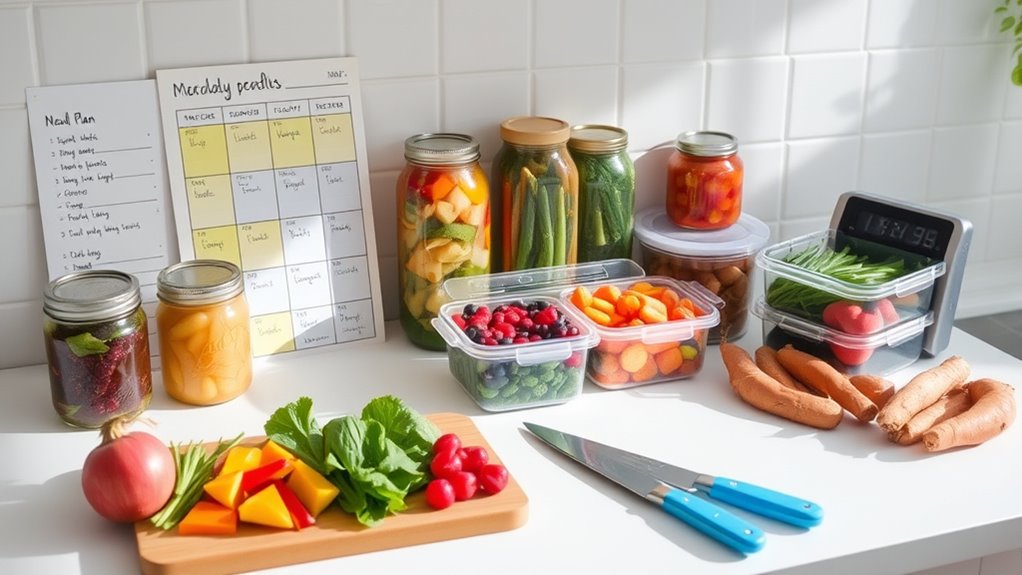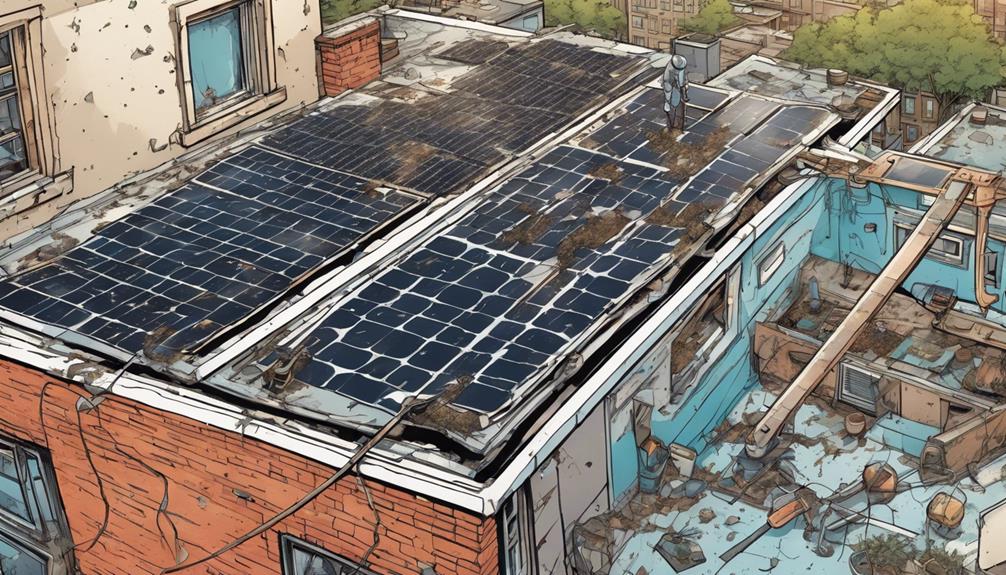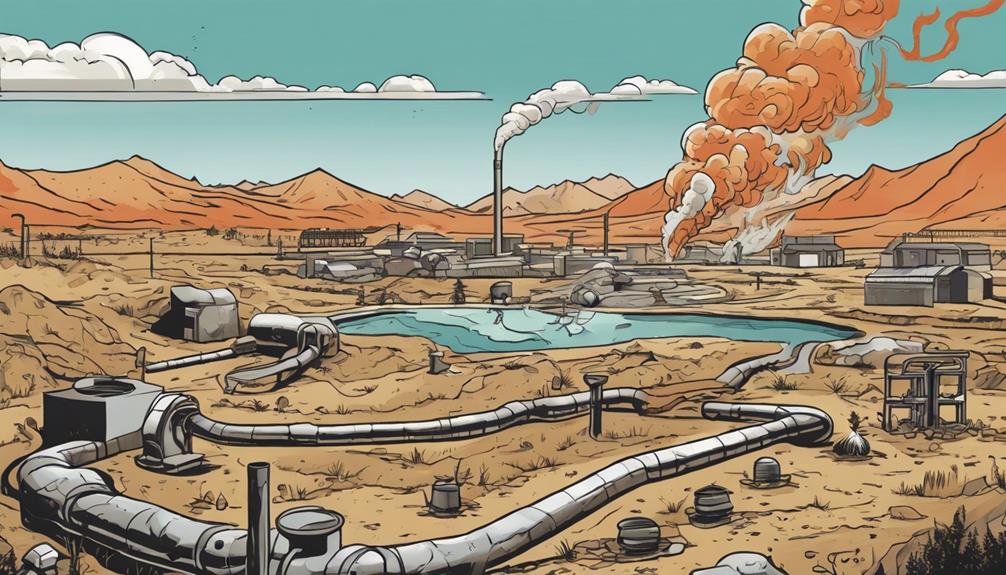To reduce food waste at home, start with meal planning to buy only what you need and create a shopping list, checking your pantry first. Store leftovers in airtight containers and freeze produce before it spoils. Use preservation methods like pickling or drying to extend food life. Don’t forget to compost scraps and donate unopened or fresh food. Implementing these tips helps save money and supports sustainability; discover more ways to minimize waste below.
Key Takeaways
- Plan meals weekly to buy only necessary ingredients and prevent overpurchasing.
- Store leftovers in airtight containers and freeze produce nearing expiration to extend freshness.
- Use preservation methods like pickling, drying, or vacuum sealing to prolong food shelf life.
- Compost organic scraps and donate unopened or fresh food to reduce waste and support community efforts.
- Check pantry and fridge before shopping to avoid duplicate purchases and minimize impulse buying.

Have you ever wondered how much food you waste each week? It’s a common question, and the answer might surprise you. A significant portion of food gets thrown away, often because it spoils before you can eat it. But you can make a real difference by adopting smarter meal planning and preservation techniques. When you plan your meals carefully, you’re less likely to buy more than you need, which reduces the chance of leftovers going bad. Start by creating a shopping list based on your weekly meals. Check your pantry and fridge beforehand to see what ingredients you already have, and focus on buying only what’s necessary. This way, you cut down on impulse purchases that often lead to excess food waste. Think about incorporating versatile ingredients that can be used in multiple dishes, so nothing goes unused.
Proper preservation is equally important. If you notice produce nearing its expiration date, consider freezing it or using it in recipes immediately. For leftovers, store them in airtight containers to extend their freshness. Many foods can be preserved through techniques like pickling, drying, or vacuum sealing, which help you enjoy them later. These methods not only minimize waste but also save you money over time. Additionally, you can adopt composting methods for scraps that can’t be eaten. Composting transforms vegetable peels, coffee grounds, eggshells, and other organic waste into nutrient-rich soil, reducing the amount of waste sent to landfills and supporting your garden. Incorporating food preservation techniques can significantly extend the life of perishable items and reduce overall waste. Using proper storage methods can further prevent spoilage and keep your food fresh longer. Staying informed about Gold IRA options can also help you make better financial decisions, just as proper food management benefits your household. If composting isn’t an option, look into local food donation programs. Many communities have food banks or charities that accept unopened, non-perishable items or even fresh produce. Donating food helps feed those in need and keeps edible food out of the trash.
Frequently Asked Questions
How Can I Start Meal Planning if I Have a Busy Schedule?
If your schedule is busy, start meal planning by setting aside 15-20 minutes weekly to create a simple meal prep plan. Make a grocery list based on easy, versatile ingredients and stick to it to save time and avoid waste. Prep ingredients ahead of time, like chopping veggies or cooking grains, so you can quickly assemble meals during the week. This approach keeps you organized and reduces last-minute food waste.
What Are the Best Ways to Store Leftovers for Long-Term Use?
To store leftovers long-term, you should use vacuum sealing to remove air and prevent freezer burn. Invest in a good vacuum sealer and use it to package leftovers tightly. Then, apply proper freezing techniques by labeling and dating each package. Store them in the freezer at consistent temperatures, and use within a few months for best quality. This method keeps your leftovers fresh and reduces waste effectively.
How Do I Identify When Produce Is Still Safe to Eat?
You can tell if produce is still safe to eat by checking ripeness indicators like color, texture, and smell. Look for spoilage signs such as mold, soft spots, or a sour odor. If fruits or vegetables feel overly slimy or have dark spots, it’s best to discard them. Trust your senses—if it looks, smells, or feels off, it’s safer to throw it out rather than risk foodborne illness.
Are There Eco-Friendly Food Storage Containers I Should Consider?
You might think all food storage containers are equal, but eco-friendly options do make a difference. Reusable containers, like glass or stainless steel, are durable and sustainable, while biodegradable options break down naturally, reducing plastic waste. These eco-conscious choices help protect the environment and keep your food fresh. Switching to these containers guarantees you’re minimizing waste and supporting a healthier planet, all while preserving your meals effectively.
How Can I Involve My Family in Reducing Food Waste?
You can involve your family in reducing food waste by encouraging family participation in meal planning and shopping. Assign shared responsibilities, like checking for leftovers or sorting recyclable containers. Make it fun by setting goals together, like reducing waste each week. When everyone contributes, they feel more responsible, fostering good habits that last. This teamwork not only cuts waste but also teaches valuable lessons about sustainability and teamwork.
Conclusion
By adopting smart meal planning and proper preservation methods, you can turn your kitchen into a fortress against food waste. Think of your efforts as planting seeds for a greener future—each small step adds up to a significant impact. When you waste less food, you’re not just saving money; you’re nurturing the planet. Remember, every mindful choice you make is like a drop in the ocean—powerful enough to create waves of change.









